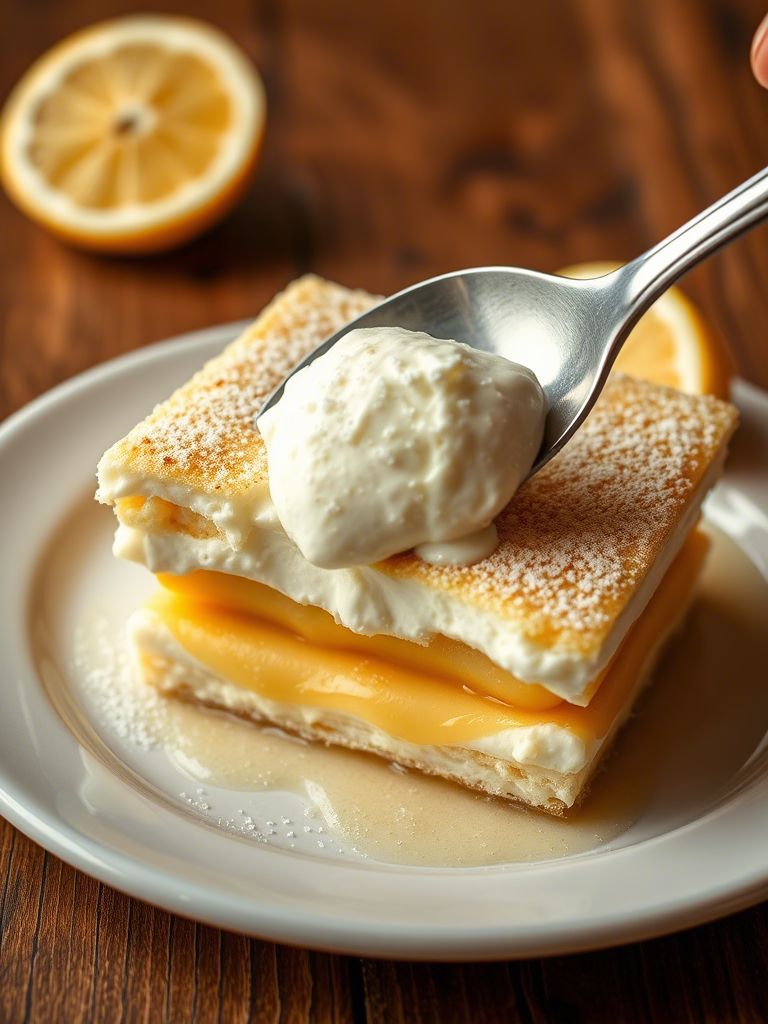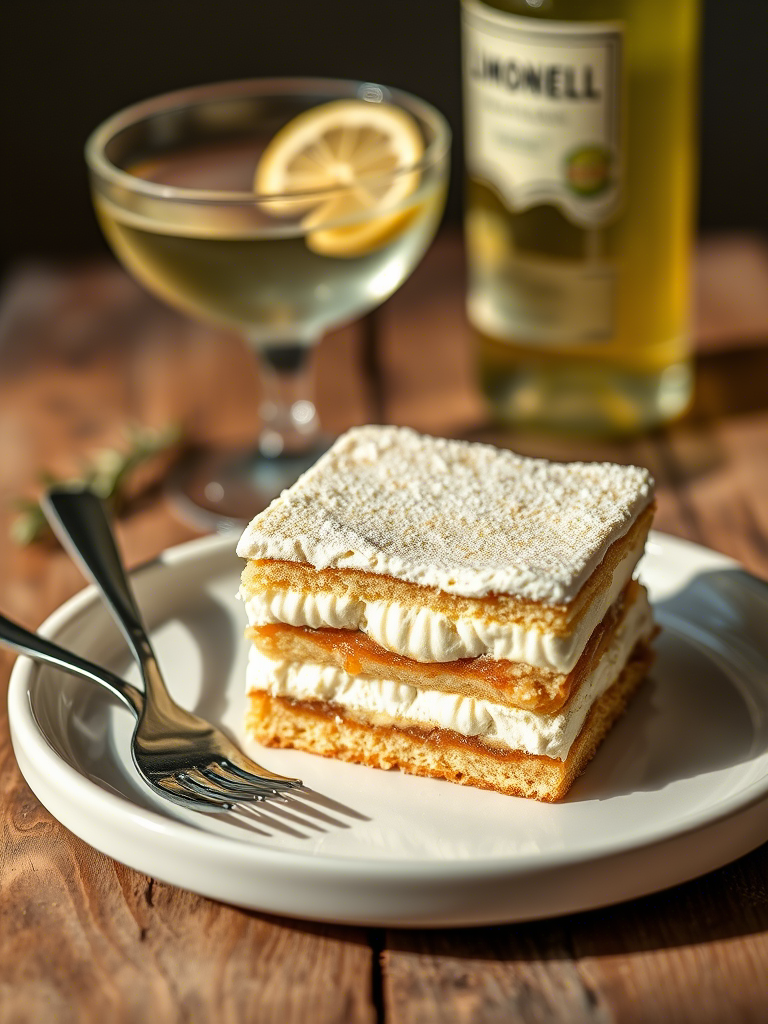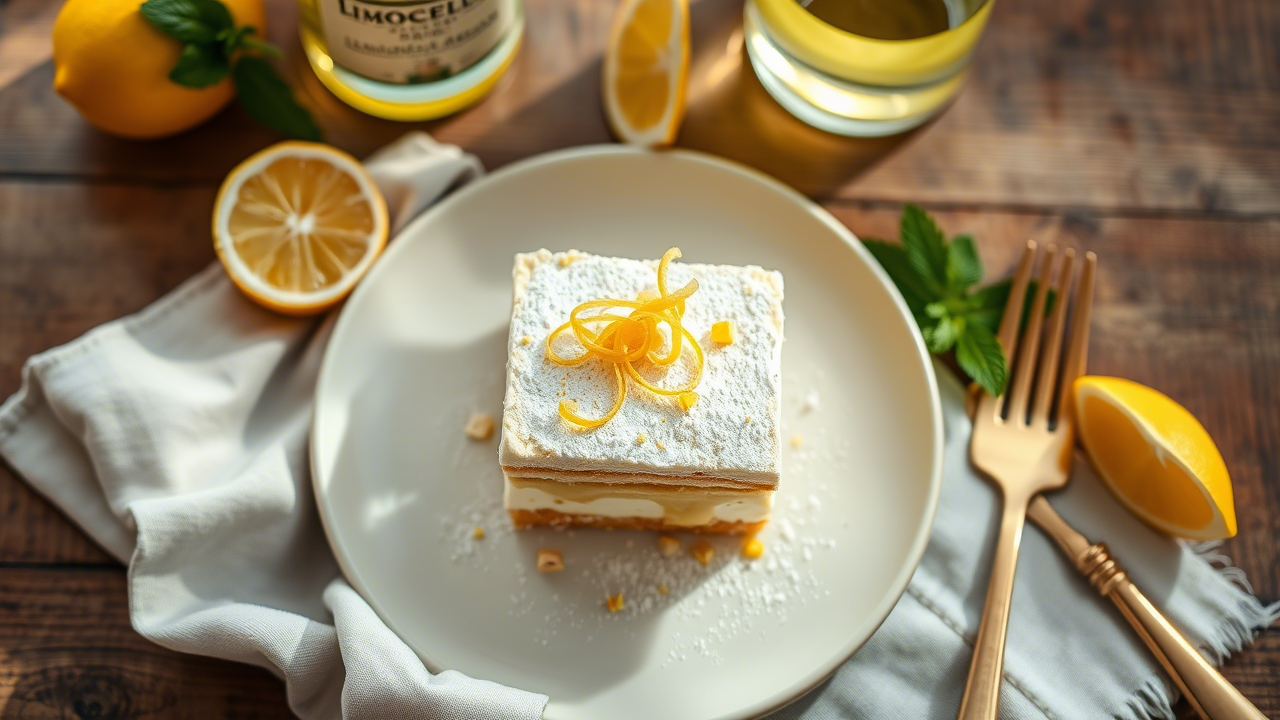It’s lemony. It’s boozy. It’s softly dangerous. If you’ve only ever had the classic espresso tiramisu, then brace yourself—Limoncello Tiramisu is not just a summer dessert; it’s a declaration.
Now, look, anyone can throw together mascarpone and ladyfingers and call it a day. But if you want something that actually sings with citrus, something with layers of depth, elegance, and punch—you gotta go further. This ain’t just dessert. It’s craft.
What we’re doing here is giving the tiramisu its sun-drenched Amalfi glow. Still creamy. Still luxurious. But oh, it’s got a little zesty bite. And it’s not just a Pinterest hack—it’s real pastry work, with real flavor balance, and a real need for restraint. Or not.
What Is Limoncello Tiramisu, Really?
Tiramisu in its traditional form means “pick me up.” With espresso and cocoa and sometimes a splash of Marsala. But what if you ditch the coffee and go for Limoncello? Now you’ve got something closer to a “wake me up with a lemon slap and tuck me in with cream” situation.
Limoncello Tiramisu swaps coffee for a lemon syrup and/or limoncello soak. That’s not news. What’s crucial is balance. You want brightness without sharpness, booziness without burn, sweetness without toothache. That’s hard. This is no amateur’s shortcut.
Most recipes online are all fluff and no bite. They either go overboard on the lemon and it curdles your cream, or they’re so gentle you might as well be eating lemon pudding. We fix that today.
Ingredients Matter, No Wiggle Room Here
Real talk: if your mascarpone is low-quality, your tiramisu is already ruined. You can’t fake that fat content. And don’t use off-brand limoncello—it’s like using box wine in a reduction. Nobody’s impressed.
Here’s what you really need to make it sing:
- Ladyfingers (Savoiardi) – Dry, crisp ones. Not spongey ones. That’s a soggy mess waiting to happen.
- Limoncello – Go for homemade if you can, but at least use something with actual lemon oil and not fake lemon flavoring.
- Mascarpone – Full-fat. No substitutions. Cream cheese? Don’t even think about it.
- Egg yolks + whites or pasteurized eggs – We’ll talk more about that.
- Heavy cream – Whipped just to soft peaks. Not stiff like cement.
- Fresh lemons – You need the zest. The real perfume comes from the zest, not the juice.
- Sugar, vanilla, sea salt – The supporting cast.
Optional: limoncello syrup reduction, white chocolate shavings, or a few crushed lemon cookies on top (if you’re feeling adventurous). But they’re extras, not essentials.
Limoncello Tiramisu: Step-by-Step Like You’ve Never Heard It Before
Let’s stop pretending this is a throw-together dish. It needs steps. It needs patience. That’s why it’s good.

1. Make the Zesty Lemon Syrup
Boil ¾ cup water with ⅓ cup sugar, zest of 1 lemon, and ½ cup limoncello. Let it simmer 4–5 minutes until it’s slightly thick but not jammy. Cool completely. This is your soak.
And no, don’t just pour limoncello straight onto the ladyfingers unless you want them to taste like regret and rubbing alcohol.
2. Whip the Egg Yolks to Silk
Take 5 egg yolks. Beat them with ½ cup sugar over a bain-marie (a fancy word for a bowl over simmering water). Whisk constantly, or you’ll end up with lemony scrambled eggs, which nobody wants.
After 6–8 minutes, the yolks should be pale, thick, and ribbon off the whisk. This is your zabaglione base. Cool it down.
Why this step? Heat stabilizes the yolks and melts the sugar. Also—texture. It’s not just about flavor here.
3. Add Mascarpone, But Gently, Please
Fold 16 oz mascarpone into the cooled zabaglione. Do this in small additions. Don’t dump and stir—it’ll break.
Mascarpone hates rough treatment. It’ll curdle and separate if you overbeat. Be kind. It’ll thank you with creamy goodness.
4. Whip the Cream and (Maybe) the Egg Whites
Whip ¾ cup heavy cream to soft peaks. If you’re feeling bold, whip 2–3 egg whites separately and fold them in for lightness. But know that raw egg whites = food safety risk.
In professional kitchens, pasteurized egg products are the gold standard. Home cooks, you decide.
Fold the cream into the mascarpone mix slowly. Layer by layer. No sudden moves.
5. Dip, Don’t Drown, the Ladyfingers
Take your ladyfingers and dip them one at a time into the cooled limoncello syrup. Count to 2. No more. They soak up fast, and if you oversoak, you’ll end up with mush.
Line them in your dish snugly. First layer down. Spread a third of the cream mixture. Repeat twice more.
The top layer should be cream. Always. Never biscuit. You’re not making a lasagna here.
Real Talk: How Long Should It Chill?
8 hours minimum. 24 hours is better. Don’t rush it.
Here’s why: the syrup needs to fully permeate the cookies, the cream needs to firm up, and the flavors need to marry. You can’t microwave your way to patience.
This dessert gets better with time. Like a fine wine or your grandmother’s opinion on your haircut.
Garnishing: Understated Elegance, Please
Skip the cocoa powder—it’s not espresso tiramisu anymore.
Instead, go with:
- Light lemon zest curls
- Thinly sliced candied lemon
- White chocolate curls (optional, but great)
- A whisper of powdered sugar
No mint leaves unless you’re doing a photoshoot for a summer wedding. Let the flavor speak, not the garnish.

Expert Insight: Alcohol Content and Taste
Let’s talk real-world impact. Limoncello averages around 25-30% ABV. But after you reduce it, soak it, and chill it overnight? Your final dessert will have less than 5% alcohol by weight. Probably lower.
Still, don’t serve it to kids or anyone avoiding alcohol. You can sub in a lemon simple syrup + lemon extract combo, but it won’t have the depth.
Pro tip: if you make your own limoncello, you control the sugar and alcohol balance. That’s power.
Troubleshooting: What Most People Get Wrong
- Soggy Ladyfingers: Overdipping. Dip quick. Don’t let ‘em float.
- Weepy Cream: Overwhipping. Once you see soft peaks, stop.
- Grainy Mascarpone Mix: Either it was too cold or overmixed. Let it warm slightly before folding.
- Lack of Lemon Flavor: Not enough zest. Don’t underestimate how much citrus oils do the heavy lifting.
Emerging Trends: Deconstructed Limoncello Tiramisu? Maybe.
High-end restaurants are taking this classic and turning it into plated art.
Instead of one big tray, you’ll see individual glasses, piped mascarpone layers, lemon gel droplets, even biscuit crumbles airbrushed with limoncello mist. It’s extra. But it sells.
If you’re plating for service, build it in ring molds or wine glasses. Use a piping bag for the cream. Show off the layers. Customers eat with their eyes first.
Data Snapshot: Tiramisu’s Popularity in Summer
According to a 2023 market report from Technomic, citrus-based desserts saw a 14% increase in summer menu rotations in North America. Lemon-based variants, including limoncello, led the trend, especially in fine dining and gastro pubs.
Tiramisu remains a top 5 dessert in Italian restaurants across the U.S., with increasing demand for “fresh takes” on the classic. That’s your cue.
Storage Tips: Can You Freeze Limoncello Tiramisu?
Yes. But not for too long. Up to 1 month, tightly wrapped. Thaw in the fridge overnight.
Be warned—freezing changes texture slightly. You’ll lose a bit of creaminess. It’s best fresh or within 3 days of chilling.
Conclusion: Why This Version Deserves a Place in Your Repertoire
Limoncello Tiramisu isn’t just a trendy twist. It’s a full reimagining that demands respect. Done right, it’s layered, fragrant, punchy, and refined.
This is a dish that tells a story. About summer. About Southern Italy. About taking something classic and not just tweaking it, but elevating it.
If you’re a professional, use this as your summer showstopper. If you’re a home cook? Surprise your guests. Make them ask, “What is this?” And then smile when they can’t stop eating.
Because when you get this dessert right, it doesn’t whisper. It shouts. With lemons. And cream. And joy.
FAQs
What is Limoncello Tiramisu?
It’s a citrusy, boozy twist on classic tiramisu made with limoncello and lemon syrup instead of coffee and cocoa.
Can I make Limoncello Tiramisu without alcohol?
Yes, use lemon syrup with lemon extract as a non-alcoholic substitute for limoncello.
How long should Limoncello Tiramisu chill?
At least 8 hours, but 24 hours gives the best flavor and texture.
What kind of limoncello should I use?
Use good-quality or homemade limoncello with real lemon zest and oils—not artificial flavors.
Can I freeze Limoncello Tiramisu?
Yes, for up to one month, though texture may slightly change after thawing.
What type of ladyfingers should I use?
Dry, crisp Savoiardi are best—they hold their structure when soaked.
How do I keep the mascarpone from curdling?
Let it come to room temperature and fold it gently into the egg yolk mixture.
Is it safe to use raw eggs in tiramisu?
Use pasteurized eggs or egg substitutes to reduce food safety risk.
Why did my tiramisu turn soggy?
Most likely you over-soaked the ladyfingers—dip quickly, don’t drench.
Can I make this dessert in individual servings?
Yes, use glasses, jars, or ring molds to serve it as elegant individual portions.

Mariana is a passionate home cook who creates delicious, easy-to-follow recipes for busy people. From energizing breakfasts to satisfying dinners and indulgent desserts, her dishes are designed to fuel both your body and hustle.
When she’s not in the kitchen, she’s exploring new flavors and dreaming up her next recipe to share with the Foodie Hustle community.

